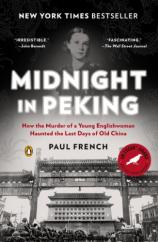Reading Group Guide
Discussion Questions
Midnight in Peking: How the Murder of a Young Englishwoman Haunted the Last Days of Old China

Midnight in Peking takes readers inside in the decadent final days of Peking before the cataclysm of Japanese occupation and World War II. It is a world of opium dens and brothels, of untouchable privilege and sexual predation, of ancient superstitions and modern anxieties. The year is 1937, the Japanese are closing in, Communists and Nationalists are skirmishing across the country, and Pekingers, both foreign and native, are on edge. Tensions rise dramatically when the mutilated body of Pamela Werner --- the nineteen-year-old adopted daughter of E. T. C. Werner, a leading scholar of Chinese culture and history and a former diplomat --- is found near the Fox Tower, just beyond the safety of the small enclave of foreigners known as the Legation Quarter.
With few clues and no obvious motive, her murder, and the savage dismemberment of her body, which has been hacked nearly beyond recognition and from which the heart and liver have been removed, is both shocking and mystifying. The superstitious blame the evil fox spirits. Others fear the Japanese committed the crime as a grim warning of what was to come. British authorities want to pin it on a Chinese as quickly as possible. Bringing the killer to justice is crucial for both the British and the Chinese to save face, and in a remarkable cultural collaboration, the Chinese detective Colonel Han teams up with the Scotland Yard–trained Detective Chief Inspector Richard Dennis to solve the crime.
Their investigation takes them deep into Peking’s Badlands --- an area taken over by opium addicts, pimps and prostitutes, and down-and-out White Russian refugees. But the case proves frustrating, with leads that go nowhere and their investigation hampered by the British, who refuse to let DCI Dennis question anyone inside the Legation Quarter, where Pamela and her father lived. Nor are the detectives allowed to fully investigate the scandalous rumors surrounding a nudist colony run by Wentworth Prentice --- a dentist and a seemingly upstanding citizen --- and attended by prominent foreigners in Peking and the young women who entertained them.
After the case is formally closed and his many impassioned appeals summarily turned down, seventy-year-old E. T. C. Werner decides to take matters into his own hands and mounts an investigation that eventually uncovers a truth far more horrifying than he could have imagined. He gathers evidence that Han and Dennis overlooked, asks questions they failed to ask, pokes his nose into dangerous places, and follows every possible lead as far as it will take him. And it is here that Paul French himself becomes a co-investigator with Werner. Working from Werner’s letters and other archival material --- newspaper accounts, legal records, and interviews with those who knew some of the participants --- he pieces together a very plausible scenario of what happened on the terrible night Pamela Werner was killed. French also deftly explores how and why it the murder was covered up.
Blending narrative history and the suspense of true crime, Paul French solves this seventy-five-year-old murder case. In the process, he paints an unforgettable picture of a Peking that was about to be engulfed in war and occupation, and brings a measure of justice to an innocent young woman and the father who pursued her killers so relentlessly.
1. In what ways does Paul French blend elements of the true-crime genre with narrative history? Why is his more novelistic approach to the story more engaging than a purely historical account might be?
2. Why is Pamela’s murder so terrifying for Pekingers? What horrors does it seem to symbolize or foretell?
3. What picture of Peking emerges in the book? How does French re-create the texture of decadence and nervousness that pervaded Peking in the late 1930s? In what sense is Peking itself a major character in the story?
4. In what ways does Pamela’s brutal murder bring into uneasy contact the privileged world of the British Legation and the seedy underworld of the Badlands? How are these seemingly disparate worlds in fact deeply intertwined?
5. Why did British ambassador John Affleck hamstring DCI Dennis’s ability to conduct his investigation? Why do British authorities refuse to reopen the case even after Werner sends them important new evidence that the original investigators overlooked or suppressed?
6. In what ways are both Pamela and her father more complicated --- and contradictory --- than they at first seem?
7. Werner turns out to have remarkable investigative abilities. He asks a number of questions the professional detectives failed to consider --- why Prentice would repaint his apartment in the dead of winter when ventilation would prove most uncomfortable; whether there was in fact a movie playing at the time Prentice used for his alibi. What other clues and leads does he follow up that Colonel Han and DCI Dennis missed?
8. How are the men who very likely participated in Pamela’s murder --- Wentworth Prentice, Joe Knauf, John O’Brian, Dr. Capuzzo, and others --- able to get away with raping innocent young women? Why don’t their victims speak out against them?
9. Does French convincingly solve the mystery of Pamela’s death? What mixture of evidence and inference most strongly supports his view --- and Werner’s own view --- that Prentice was the killer?
10. How does Midnight in Peking speak to our own time? In what ways are some of the social problems the book explores --- the sexual exploitation of women, the ability of the rich and powerful to evade the law or suppress the truth, the desperation and drug use caused by poverty, etc. --- still with us?
Midnight in Peking: How the Murder of a Young Englishwoman Haunted the Last Days of Old China
- Publication Date: April 30, 2013
- Genres: Nonfiction, True Crime
- Paperback: 272 pages
- Publisher: Penguin Books
- ISBN-10: 014312336X
- ISBN-13: 9780143123361








